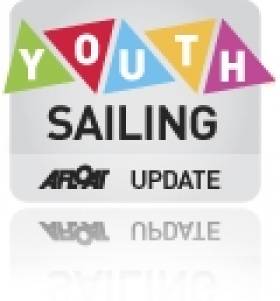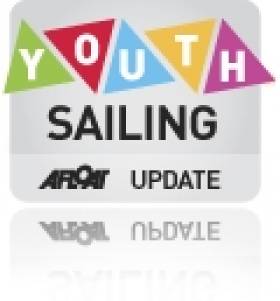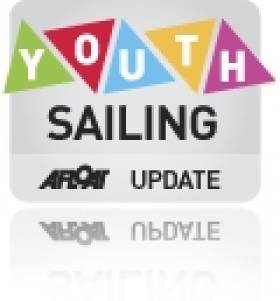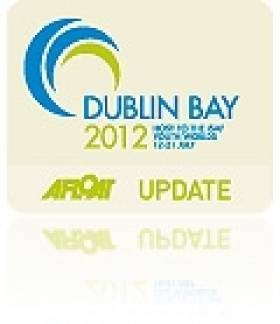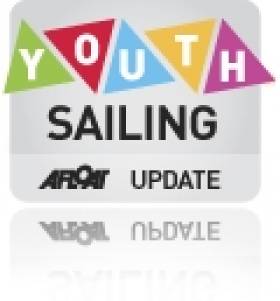Displaying items by tag: youth sailing
UCD Crowned Student Yachting World Champions in France
#sywoc – Ireland's UCD sailing team have beaten Canada by 12 points to win the Student Yachting World Cup in France after the series was shortened due to gales in La Rochelle. The Irish team took the lead on Tuesday and extended it after being reinstated in a race they were previously disqualified from.
The event had been decided on the results of 13 races and two discards. IRL were clear winners on 25 points from Dalhousie University on 37 points and Italy's CUS Brescia in third place on 41 points. 14 Teams competed. (See full results sheet for download below).
It is the second time Ireland has won the prestigious trophy, Cork Institute of Technology won in 2008.
The Irish team claimed victory by the largest margin ever recorded by an Irish team competing throughout the 32 year history of the event. Team Ireland dominated the regatta by consistently scoring podium places in almost all of their 13 races throughout the championship to finish on a total of 25 points while their closest rivals, Team Canada, finished on 37 points.
The regatta which was held in La Rochelle, France, saw the top 14 teams from around the world compete for six days in wide ranging sailing conditions and race course formats. Team Ireland set down a clear marker of their intentions on the first day of the regatta by carding two second places. Team Ireland took a little longer to find their groove on the inshore race course however carding an eighth place, leaving them in third place overall on the first evening.
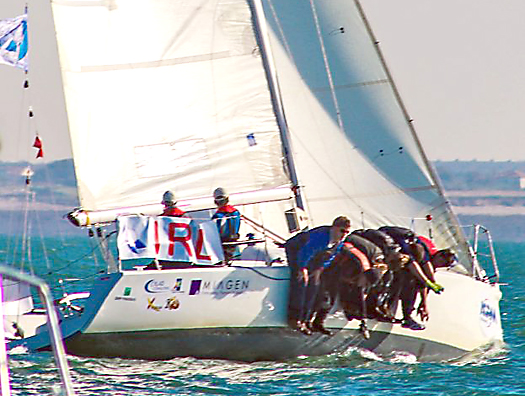
UCD hike hard on their way to a World tite win in La Rochelle
From there, the team's ability and confidence improved as they learned how to sail the boat most effectively in the varying wind and wavy conditions that La Rochelle produced on a daily basis. Team skipper Aidan Mc Laverty produced some breath-taking start line manoeuvres when jostling with the other nations trying to ensure the team started at the most favourable end of the start line on each occasion. Team Ireland's tactician Barry Mc Cartin's research on wind and tides in La Rochelle paid dividends as he frequently called the best lines and angles to sail the team around the course.
Day two of the regatta brought similar sailing conditions with a short chop and 12 knots of breeze. Team Ireland carded once again two second place finishes and an unfortunate "Did Not Finish" in the inshore race due to a navigational error. It was at this stage in the regatta where Team Ireland's training began to show as sail trimmers Simon Doran and Cathal Leigh-Doyle ensured the team maintained the best boat speed in the fleet.
The regatta brought numerous twists and turns on day three as the team carded a third place finish followed by two first place finishes in race numbers 8 and 9. The team utilised their subs tactically by brining on Ben Fusco and Ellen Cahill for the night race. This six hour long race was started at 16.30 and provided a unique tactical challenge to the team who had to cope with pitch black darkness as they sailed around La Rochelle bay. The team fought extremely hard in the testing conditions and finished third only securing their place on the last 20 meters of the race. Team Ireland's pit crew member Alyson Rumball, played a crucially influential role in ensuring our sail changes went smoothly and quickly throughout the night.
Going into the final three days of the regatta, Team Ireland had the smallest of cushions over second place Team Canada. Team fitness allowed the team to push on in the increased winds. Team mast man Theo Murphy and bowman David Fitzgerald excelled in the conditions and allowed them to out manoeuvre the other teams downwind while Bella Morehead trimmed brilliantly downwind.
Unfortunately, the last two days of the regatta had to be cancelled due to winds gusting 40 knots on the race course. However, Team Ireland's lead of 12 points ensured they secured the prestigious trophy and won the regatta. As a result of their win, Ireland Sailing Team –UCD will return to defend their title next year in France.
The team have to thank everyone for their support in the lead up and during the event. Support from Ireland and across the world during the regatta has been amazing and kept the team motivated and focused on representing our country.
Video Evidence Reinstates UCD as Irish Lead at Student Yachting Cup
#sywoc – UCD sailing team extended their overall lead at the Student world Yachting Cup in La Rochelle France yesterday after producing video evidence to prove they should not have been disqualified from Tuesday's racing for a premature start rule infringement.
Overturning the decision means the UCD team now lead the world championships by 11 points overall.
According to team captain Cathal Leigh Doyle UCD discovered a video of the start oin question that showed UCD acutally under the line when the start flag was dropped!
There are only two races left to sail in the series and sailing is called off todaywith 27-33 knots. The forecast for tomorrow is similar or worse. The latest they can start a race is 1.30 tomorrrow.
UCD Sailing Team Chase Lead at Student Yachting World Cup
#ucd – UCD sailing team lie second in La Rochelle, France this morning buoyed up by a string of consistent results that sees them chasing overall leaders Canada by four points after xx race sailed so far in the Student Yachting World Cup.
UCD, captained by Cathal Leigh Doyle came second in six of the races so far which has tightened up the event leaderboard after discard. Yesterday UCD got out of the blocks with a second and another second and then a 13th.
Although lack of funding has already led to the withdrawal of two teams from next week's competition, Team Ireland under captain Cathal Leigh Doyle is celebrating a deal with sponsor Miagen in the nick of time.
A last minute deal for the team has given them a boost for their world title assautl, a title won previously by the Cork Institute of Technology.
The annual regatta attracts the top student sailors from around the world including Australia, Canada, Japan, the UK and the USA.
Heavy weather is due later on this week.
Nine Wins Gives Lyden Junior All Ireland Sailing Title
#youthsailing – Nine wins from nine races gave Fionn Lyden the Junior All Ireland Sailing Championship this afternoon in Schull, West Cork. Scroll down to download full results as a pdf.
Lyden, a member of Schull's Youth Team that lifted the under 21 trophy at the Wilson trophy at West Kirby in the UK in May, capped off the 2012 season with the storming win in the locally built TR3.6 dinghy.
Conditions remained ideal for the Irish Sailing Association (ISA) event with a steady easterly breeze of between 10 and 12 knots on the windward leeward courses today.
Under the management of David Harte, racing got off to a good start at 10.30am and Fionn and his crew of Anna O'Regan were quick to take the lead yet again. Continuing their domination of the fleet, the duo from Schull Community College Sailing Club were unbeatable in the locally built boat TR3.6 dinghy as they won all three of the remaining fleet races putting them on 7 points entering the medal race followed by Finn Lynch and his crew Sean Donnelly on 24 points and Eoin Lyden and Darragh McCormack on 28 points in third place.
At 1.25pm the top 10 sailors, consisting of eight boys and two girls, crossed the start line for the last time. Fionn got off to a bad start but echoing his skill from the previous races, he sailed hard and rounded the first mark in first place. The wind dropped off to only 3 knots at the windward mark but Fionn extended his lead while his cousin Eoin Lyden chased him in vain from second place. Never wavering from his leading position, Fionn crossed the finish line in first place.
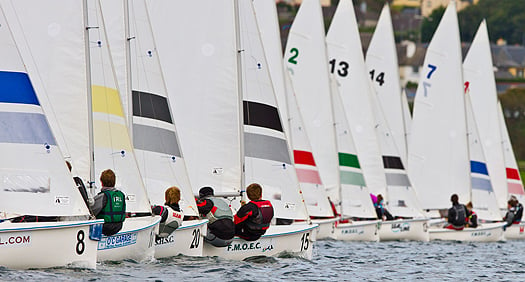
The TR3.6 dinghy fleet in action. Photo: Brian Carlin
Meanwhile Finn Lynch from the National Yacht Club and Eoin Lyden from Royal Cork Yacht Club had been fighting it out for the silver. Finn had a four point lead going in to the medal race but the 2012 ISAF Youth Worlds silver medallist had a disastrous final race finishing in 10th place. The additional 20 points meant he dropped to third overall to take the bronze.
Eoin however sailed a great race finishing in second place moving him up to second overall to take the silver.
Competing for the title of First Girl were Aisling Keller from Lough Derg and Laura Gilmore from Northern Ireland. Both girls had sailed a strong regatta with a total of nine top 10 finishes between them but ultimately a 4th in the medal race for Aisling saw her finish the regatta in 7th overall taking the prize for Frist Girl with Laura finishing in 9th overall.
Lyden Takes Early Lead at Junior All Ireland Sailing Champs
#youthsailing – Fionn Lyden and Anna O'Regan from Schull Community College Sailing Club lead the All Ireland Junior Championships in Schull this evening. Download full results as pdf below.
The Current European U17 Laser Radial champion Finn Lynch from the National Yacht Club crewed by Sean Donnelly finished second in four of the races is four points adrift on 8 points overall. In third place and on 16 points is Eoin Lyden and Darragh McCormack from Royal Cork Yacht Club.
The invitational regatta saw 21 of Ireland's top young sailors take to the water in TR3.6 dinghies for the initial five races. A further three more races are schedlued for tomorrow followed by a double points medal race decider for the top 10 sailors.
Bray SC Getting Young Sailors Afloat With Pico Club
#YOUTH SAILING - Bray Sailing Club has launched a new initiative to get young people out on the water this summer.
As the Sunday Independent reports, the Pico Club is named for the easy-to-sail Laser Pico dinghy that's just the vessel for young novices to get to grips with the basics of sailing.
The new club is open to all aged from eight to 18 and meets every Saturday for activities on the coast between Bray and Dun Laoghaire, such as picnics on Dalkey Island.
Taster sessions are free, with full membership (which includes a year's membership of Bray Sailing Club proper) priced at €96. For more details contact [email protected] or visit www.braysailingclub.ie.
Young People Going Somewhere
#sailing on Saturday – How many of the hundreds of contestants in the Four Star Pizza Youth Worlds getting under way in Dun Laoghaire this weekend will go on to achieve adult fulfillment as international sailing stars?
As with other sports, sailing sometimes has a problem in translating junior success into longterm adult achievement. Suddenly, the sheer pressure of expectation and achievement results in a complete turnoff in the enthusiasm of rising stars. They may even rebel by taking up golf or gardening.
Yet when we consider just some of the names of sailing greats who first came to prominence through the Youth Worlds, it would be obtuse not to be swept along in the wave of enthusiasm which this massive championship is engendering.
People like Russell Coutts, Ben Ainslie, Chis Dickson and Robert Scheidt have emerged as stars of the future from the Youth Worlds. Irish sailing also has its host of Youth Worlds graduates, the best-known being Olympic Silver Medallist David Wilkins, and this year's Olympic participants Peter O'Leary, David Burrows, and Annalise Murphy.
In addition to trophies for individual sailors and crews, the all-squad Nations Trophy provides a significant extra dimension, with France the defending title-holders. Their entry Groupama having clinched her win of the Volvo Ocean Race in Galway last weekend, the French team are under extra pressure to keep the title. But – hear this – they're up against 350 young sailors from 63 different nations.
The Youth Worlds is just that – totally worldwide, utterly global. The Irish squad are Sophie Murphy (Laser Radial, Strangford Lough), Finn Lynch (Laser Radial, Dun Laoghaire), Patrick Crosbie & Grattan Roberts (420, Cork), Alexander Rumball & Rory McStay (SL16 Catamaran, Dun Laoghaire), and Sean and Tadhg Donnelly (29er, Dun Laoghaire).
Necessity being the mother of invention, the current financial restraints on campaigning cruiser-racers in far-flung events has been giving the spin doctors a merry time. It doesn't do the job to describe a regatta with a significantly lowered entry list as being small but perfectly formed. But boutique will do very nicely, thank you.
So we'd a boutique series for the Scottish championship back in June, as scarcely any Irish boats could afford to go, and they're usually 30% of the entry. Now in Crosshaven they've coined the handy phrase "Boutique Week" for this year's Cork Week. But though numbers may be down, the sport is quite something, and heavy hitters such as Piet Vroon's Ker 46 Tonnere de Breskens from the Netherlands, Mike Bartolomew's Summit 40 Tokoloshe from South Africa, and Jamie McWilliam's sister-ship Peninsula Signal 8 from Hong Kong have been having mighty racing.
Meanwhile the seasoned campaigners of the International Dragon Class have been quietly building a head of steam towards their main event, the Gold Cup in Kinsale in September. The 2012 programme's focus on Ireland has got off to a useful start with a good turnout for the Edinburgh Cup on Belfast Lough, and an excellent result for the home squad, the title going to Simon Brien who finished tops with defending champion Martin Byrne of Dun Laoghaire in the runner-up slot.
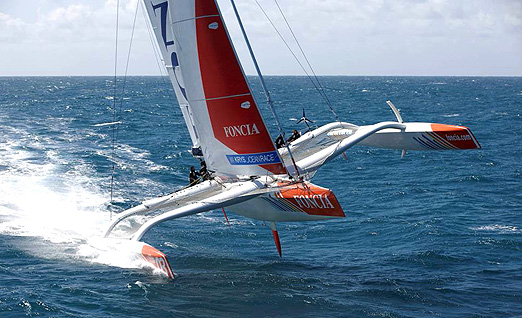
Foncia skippered by former Figaro star Michel Desjoyeaux took third in this week's Krys MOD 70 Transatlantic Race at an average speed of 24.96 knots.
And on this Bastille Day morning, Vive la France! They're defending champions in Dublin Bay for the next week, they topped the Volvo Race leaderboard in Galway a week ago, and in recent days while we've all been grumbling about the weather, the first four of the new French-inspired MOD 70s have been scorching across the Atlantic from New York to Brest at speeds well in excess of 30 knots, with the leaders averaging better than 25 knots all the way cross the pond.
An MOD 70 is a state-of-the-art trimaran, 70ft in length and so light the all-up weight of one of them is less than the 8.7 tons of a Volvo 70s keel. Developed during the past three years, they've anticipated the proposed future setup of the Volvo boats by being one design. But as with any mighty leap, resources have been stretched, and though nine boats have been started to build in France, to date just five have been commissioned.
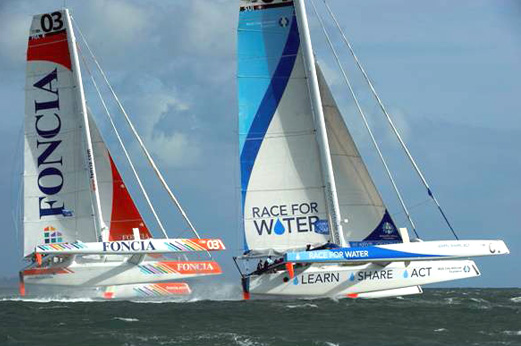
Coming to a bay near you....the fantastic new MOD 70 class will be in Dublin Bay in September. They've just completed their first Transatlantic Race with the winner and runner-up crossing in less than five days from New York to Brest, averaging better than 25 knots.
However, for their first big international event, this week's Transatlantic dash, they secured the sponsorship of Krys. Solid backing, this – they're the French equivalent of Spec-Savers just in case your google persists in steering you towards a Cayman Islands-based global insolvency consultancy, or various pop stars.
Anyway, with Krys to clarify the vision, they got four of the boats to the US where they made a formidable impression in Newport before racing down to New York, with Steve Ravussin and his team on Race for Water taking the honours on that initial sprint. It was from Manhattan on Sunday that they zoomed away into the Atlantic, but the early leader (it was Ravussin again) impacted with what is believed to have been a container, so he'd to slow back and didn't get to Brest until last night, in fourth place.
That a damaged boat could still cross the Atlantic in less than six days gives some hint of what was happening among the three which were still in the hunt. They were screaming along. First to finish on Thursday in 4 days 21 hours and 8 minutes was Yann Guichard's Spindrift Racing, an average of 25.3 knots. Groupe Edmond de Rothschild, skippered by Sebastien Josse, also was above 25 knots, while third placed Foncia (Michel Desjoyeaux), was just under, clocking an average of 24.96 knots.
So it's a beautiful Bastille Day in Brest this Saturday morning. And the MOD 70 show will be coming to Dublin Bay in September – hang onto your hats.
W M Nixon's sailing column is in the Irish Independent on Saturdays
#isafyouthworlds – A five Irish boat team that is a mix of youth and experience will take on the world's most outstanding youth talent and are tasked with bringing home a medal on home waters this week. It's a big ask given Ireland's only past medal performance in the competition's modern format was way back in 1996 when girls duo Laura Dillon and Ciara Peelo won bronze sailing a Laser II dinghy.
Dun Laoghaire sailors fill four of the five slots on the Irish squad for the Championship that is the biggest of its kind to be ever held in Ireland. This morning Dun Laoghaire clubs are being cleared of members boats to make way for the arrival of 350 sailors, 120 Team leaders/Coaches, 63 Nations, 265 boats and 400 volunteers.
Afloat 175 race management volunteers are taking to the water in 75 ribs and 20 official race boats. David O'Brien has more on this in thee Irish Times newspaper here.
The Irish team was selected after an intensive four day battle at the Irish Mitsubishi Youth National championships on Dublin Bay last April.
It will be Sophie Murphy's third time to represent Ireland at the ISAF Youth World Championships (a first for any Irish female sailor). Having also sailed at four World Championships, and five European Championships and one Youth Olympic Games the team's only girl has the most experienced of the eight sailors.
Last year the Royal St.George and Quoile YC sailor who races in the Laser Radial finished 11th overall at the Croatian event, the best result for Ireland in the female single handed dinghy since 1971 when the ISAF Youth World Championships started.
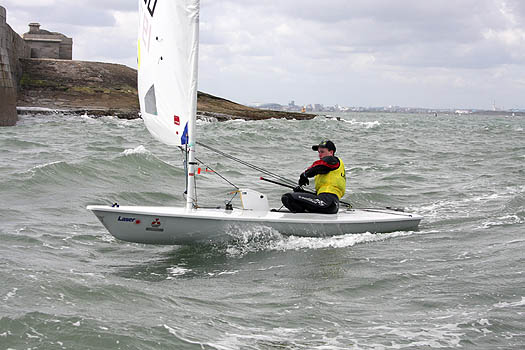
Finn Lynch makes his youth worlds debut on home waters
Sixteen year old Finn Lynch makes his worlds debut after domination of the domestic Topper scene winning national titles from 2008 to 2010. He also won the British Topper title in 2010 before moving to the Laser Radial.
Royal Cork pairing Patrick Crosbie and Grattan Roberts compete in the 420 dinghy and bring experience from a wide range of sailing including competition in Optimists, RS Feva, Laser 4.7s, Toppers, National 18s and keelboats.
In spite of only stepping in to the 29er skiff at Christmas former Optimist dinghy sailors Sean and Tadgh Donnelly from the National YC are aiming for a medal race spot at the end of this week.
Likewise Alexander Rumball and Rory McStay take their place on the start line only after a winter of hard work on the water moving from monohull dinghies to the Spitfire and ultimately SL16 catamaran, to become Ireland's first Catamaran crew at this event.
Whatever the outcome for Ireland there is no doubt the event forges future sailing careers. Many of this week's competitors will progress to Olympic level. ISAF is quick to point out that these are the 'sailing stars of tomorrow'.
'Many of the competitors at this month's Olympic regatta started their careers at this event, including Britian's sailing superstar Ben Ainslie' says ISAF's Fiona Kidd.
Ainslie's not alone. Others include Laser Radial sailor Paige Railey from the USA who will compete against Dun Laoghaire's Annalise Murphy in Weymouth has also won Gold at youth level.
Significantly Murphy herself is a past youth worlds competitor as are Irish Olympic Star keelboat pairing Peter O'Leary and David Burrows.
Irish 2012 Youth Sailing Team
Laser Radial Boy: Finn Lynch (National YC)
Laser Radial Girl: Sophie Murphy (Royal St George YC/Quoile YC)
420 Boys: Patrick Crosbie & Grattan Roberts (Royal Cork YC)
29er: Sean & Tadhg Donnelly (National YC)
SL16 Catamaran Class: Alexander Rumball and Rory McStay (Royal Irish YC/Royal St George YC/Irish National SC)
Sir Bob Geldof to Present Sailing Awards in Dun Laoghaire
#dmyc – Sir Bob Geldof will present an award made in memory of his late father to an outstanding junior sailor in Dun Laoghaire next month. The 'Bob Geldof Spirit of Sailing Award' for outstanding junior sailors will be presented at the Dun Laoghaire Motor Yacht Club (DMYC) where Bob senior was a founder member, on Saturday, July 21st next.
Welsh Youngsters Learn at Ysgol y Môr (School of the Sea)
youthsailing – Schools from Ynys Môn (Isle of Anglesey) and Gwynedd have won praise from Welsh Government member Ieuan Wyn Jones for spearheading a revolutionary approach to education, which makes the marine environment a key part of learning.
At the Ysgol y Môr (School of the Sea) Race Day 2012, at the Plas Menai National Watersports Centre near Caernarfon, more than 200 children from 13 local schools demonstrated how they have developed their knowledge of subjects ranging from renewable energy technology to marine biology, as well as watersport skills, by taking part in the first initiative of its kind in the UK, being piloted over three years.
Mr Wyn Jones said: "I am very impressed with this pilot project. The schools have clearly got a great deal out of it and I want to work with the Ysgol y Môr team to see how we can develop it further."
Sponsored by nuclear power technology specialists EnergySolutions, who own Magnox Ltd, the day featured an inter-schools regatta of sailing, kayaking and windsurfing races: a marine renewables regatta, run by Engineering Your Future, showcasing pupils' work on solar powered boats, wind and water turbines, and fuel cell technology, culminating in a solar boat race; and a Classe de Mer (Classroom of the Sea) display, showcasing pupils' work on marine wildlife, conservation, maritime culture, history and landmarks on the Menai Strait, ocean sciences, coastal living and dune formation, art and literature.
The event also hosted an Ysgol y Môr Conference for 100 delegates, with Ieuan Wyn Jones AM as keynote speaker, a video about Nautisme en Finistere (Brittany's equivalent of Ysgol y Môr), and presentations by the region's head teachers and an independent assessor on the value of the programme.
Dave Callen, EnergySolutions' Engineering Manager at Magnox Wylfa Power Station, said: "Education is one of the keys to North West Wales' economic and cultural sustainability – and so are the region's marine resources, including energy. We are delighted to sponsor this inspiring event."
Hundreds of youngsters are learning subjects including renewable energy technologies and watersports.
Jon Philips, Director of Stakeholder Relations for the Nuclear Decommissioning Authority (NDA), one of the principal funders of the project, said: "The NDA is delighted to have supported this programme, which we hope will inspire future generations to consider the exciting employment and business opportunities associated with the coastal environment – creating an even more vibrant and exciting place to live and work."
Ysgol y Môr is the first initiative in the UK to use the marine environment as part of mainstream education.
It is modelled on a 30+ year educational programme in Brittany, which has been the driving force behind the growth of the region's highly successful marine industry. It has created major economic development and sustainable jobs, which have helped safeguard the Breton language and culture.
Ysgol y Môr is being piloted in the counties of Gwynedd and Ynys Môn. In the first phase, spanning three years, 1440 pupils from 16 schools are learning watersports skills. 1170 pupils are being taught a range of existing curriculum subjects in classes de mer ('classrooms of the sea'), across both counties.
The launch of Ysgol y Môr followed more than three years of development by North Wales Watersports and its partners. This included a fact finding mission for North Wales educationalists and local authority representatives in 2007 to Brittany, which has 20 dedicated 'classrooms of the sea' centres that have trained thousands of pupils.
The Ysgol y Môr programme is designed as a template for a new national approach to education, based on involving pupils more closely with their local environments, including mountains, forests and urban areas.


























